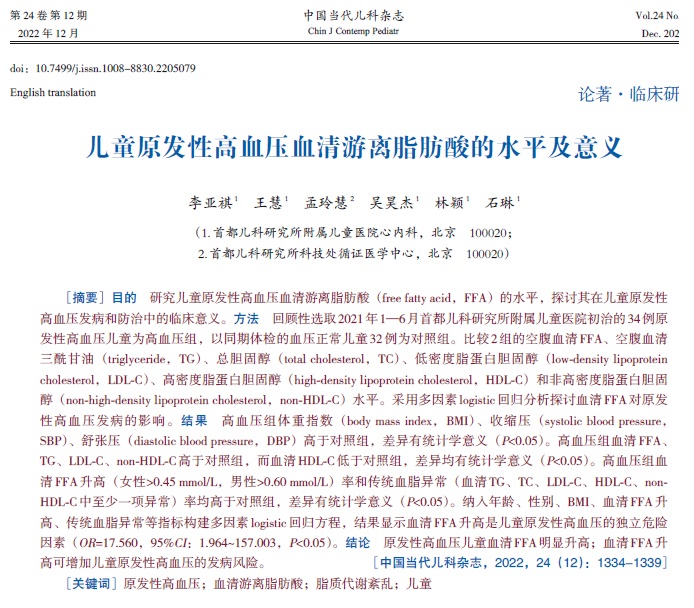Objective To examine the serum level of free fatty acid (FFA) in children with primary hypertension and its value in the pathogenesis, prevention, and treatment of primary hypertension in children. Methods In this retrospective study, 34 children with primary hypertension who were treated for the first time in Children's Hospital Affiliated to Capital Institute of Pediatrics from January to June, 2021, were enrolled as the hypertension group, and 32 children with normal blood pressure who underwent physical examination during the same period were enrolled as the control group. The two groups were compared in terms of the levels of fasting serum FFA, fasting serum triglyceride (TG), total cholesterol (TC), low-density lipoprotein cholesterol (LDL-C), high-density lipoprotein cholesterol (HDL-C), and non-high-density lipoprotein cholesterol (non-HDL-C). The multivariate logistic regression model was used to analyze the influence of FFA on the development of primary hypertension. Results Compared with the control group, the hypertension group had significantly higher body mass index (BMI), systolic blood pressure, and diastolic blood pressure (P<0.05), as well as significantly higher serum levels of FFA, TG, LDL-C, and non-HDL-C and a significantly lower serum level of HDL-C (P<0.05). Compared with the control group, the hypertension group had significantly higher rates of elevated serum FFA (>0.45 mmol/L for girls and >0.60 mmol/L for boys) (P<0.05) and abnormal blood lipid levels (abnormality in at least one index among serum TG, TC, LDL-C, HDL-C, and non-HDL-C) (P<0.05). A multivariate logistic regression equation was established based on age, sex, BMI, elevated serum FFA, and abnormal blood lipid levels, and the results showed that elevated serum FFA was an independent risk factor for primary hypertension in children (OR=17.560, 95%CI: 1.964-157.003, P<0.05). Conclusions There is a significant increase in serum FFA level in children with primary hypertension, and the increase in serum FFA can increase the risk of primary hypertension in children.
Key words
Primary hypertension /
Serum free fatty acid /
Lipid metabolism disorder /
Child
{{custom_sec.title}}
{{custom_sec.title}}
{{custom_sec.content}}
References
1 Unger T, Borghi C, Charchar F, et al. 2020 International Society of Hypertension global hypertension practice guidelines[J]. Hypertension, 2020, 75(6): 1334-1357. PMID: 32370572. DOI: 10.1161/HYPERTENSIONAHA.120.15026.
2 中国高血压防治指南修订委员会, 高血压联盟 (中国, 中华医学会心血管病学分会, 等. 中国高血压防治指南 (2018年修订版)[J]. 中国心血管杂志, 2019, 24(1): 24-56. DOI: 10.3969/j.issn.1007-5410.2019.01.002.
3 陈源源, 王增武, 李建军, 等. 高血压患者血压血脂综合管理中国专家共识[J]. 中华高血压杂志, 2019, 27(7): 605-614. DOI: 10.16439/j.cnki.1673-7245.2019.07.002.
4 Pool LR, Aguayo L, Brzezinski M, et al. Childhood risk factors and adulthood cardiovascular disease: a systematic review[J]. J Pediatr, 2021, 232: 118-126.e23. PMID: 33516680. DOI: 10.1016/j.jpeds.2021.01.053.
5 Rai S, Bhatnagar S. Novel lipidomic biomarkers in hyperlipidemia and cardiovascular diseases: an integrative biology analysis[J]. OMICS, 2017, 21(3): 132-142. PMID: 28157411. DOI: 10.1089/omi.2016.0178.
6 Henderson GC. Plasma free fatty acid concentration as a modifiable risk factor for metabolic disease[J]. Nutrients, 2021, 13(8): 2590. PMID: 34444750. PMCID: PMC8402049. DOI: 10.3390/nu13082590.
7 Hong S, Song W, Zushin PH, et al. Phosphorylation of beta-3 adrenergic receptor at serine 247 by ERK MAP kinase drives lipolysis in obese adipocytes[J]. Mol Metab, 2018, 12: 25-38. PMID: 29661693. PMCID: PMC6001906. DOI: 10.1016/j.molmet.2018.03.012.
8 Guo SX, Yan YZ, Mu LT, et al. Association of serum free fatty acids with hypertension and insulin resistance among rural Uyghur adults in far western China[J]. Int J Environ Res Public Health, 2015, 12(6): 6582-6590. PMID: 26067991. PMCID: PMC4483717. DOI: 10.3390/ijerph120606582.
9 毛滢, 卢佩颖, 周骏, 等. 高血压病患者与血清游离脂肪酸水平和炎症因子的相关性分析[J]. 中国卫生检验杂志, 2019, 29(19): 2368-2370.
10 李东风, 董晓飞. 高血压病合并急性脑梗死患者血清游离脂肪酸的表达水平及临床意义[J]. 泰山医学院学报, 2019, 40(1): 28-30. DOI: 10.3969/j.issn.1004-7115.2019.01.008.
11 中国成人血脂异常防治指南修订联合委员会. 中国成人血脂异常防治指南(2016年修订版)[J]. 中华全科医师杂志, 2017, 16(1): 15-35. DOI: 10.3760/cma.j.issn.1671-7368.2017.01.006.
12 中华医学会儿科学分会罕见病学组, 中华医学会儿科学分会心血管学组, 中华医学会儿科学分会儿童保健学组, 等. 儿童脂质异常血症诊治专家共识(2022)[J]. 中华儿科杂志, 2022, 60(7): 633-639. PMID: 35768349. DOI: 10.3760/cma.j.cn112140-20211108-00936.
13 马淑婧, 羊柳, 赵敏, 等. 1991—2015年中国儿童青少年血压水平及高血压检出率的变化趋势[J]. 中华流行病学杂志, 2020, 41(2): 178-183. PMID: 32164126. DOI: 10.3760/cma.j.issn.0254-6450.2020.02.008.
14 李丹, 李晓惠, 石琳, 等. 住院儿童高血压232例病因构成与临床分析[J]. 中华实用儿科临床杂志, 2019, 34(13): 993-996. DOI: 10.3760/cma.j.issn.2095-428X.2019.13.007.
15 Kharazmi-Khorassani J, Ghafarian Zirak R, Ghazizadeh H, et al. The role of serum monounsaturated fatty acids (MUFAs) and polyunsaturated fatty acids (PUFAs) in cardiovascular disease risk[J]. Acta Biomed, 2021, 92(2): e2021049. PMID: 33988177. PMCID: PMC8182619. DOI: 10.23750/abm.v92i2.9235.
16 林瑶, 石琳, 米杰, 等. 儿童代谢综合征与原发性高血压靶器官损害的关系[J]. 中国实用儿科杂志, 2018, 33(2): 135-139. DOI: 10.19538/j.ek2018020613.
17 Ghosh A, Gao L, Thakur A, et al. Role of free fatty acids in endothelial dysfunction[J]. J Biomed Sci, 2017, 24(1): 50. PMID: 28750629. PMCID: PMC5530532. DOI: 10.1186/s12929-017-0357-5.
18 Le Master E, Levitan I. Endothelial stiffening in dyslipidemia[J]. Aging (Albany NY), 2019, 11(2): 299-300. PMID: 30674709. PMCID: PMC6366977. DOI: 10.18632/aging.101778.
19 马晶晶, 崔雅茜, 石琳. 儿童原发性高血压与血管内皮细胞的关系[J]. 中国医刊, 2019, 54(11): 1183-1186. DOI: 10.3969/j.issn.1008-1070.2019.11.008.
20 Sun X, Pan H, Tan H, et al. High free fatty acids level related with cardiac dysfunction in obese rats[J]. Diabetes Res Clin Pract, 2012, 95(2): 251-259. PMID: 22088789. DOI: 10.1016/j.diabres.2011.10.028.
21 Yasu T, Mutoh A, Wada H, et al. Renin-angiotensin system inhibitors can prevent intravenous lipid infusion-induced myocardial microvascular dysfunction and leukocyte activation[J]. Circ J, 2018, 82(2): 494-501. PMID: 28954968. DOI: 10.1253/circj.CJ-17-0809.
22 曹荟哲, 哈小琴, 李雪雁, 等. 游离脂肪酸致胰岛素抵抗的分子机制[J]. 解放军医学杂志, 2017, 42(1): 81-85. DOI: 10.11855/j.issn.0577-7402.2017.01.16.
23 da Silva AA, do Carmo JM, Li X, et al. Role of hyperinsulinemia and insulin resistance in hypertension: metabolic syndrome revisited[J]. Can J Cardiol, 2020, 36(5): 671-682. PMID: 32389340. PMCID: PMC7219403. DOI: 10.1016/j.cjca.2020.02.066.
24 Varady KA, Dam VT, Klempel MC, et al. Effects of weight loss via high fat vs. low fat alternate day fasting diets on free fatty acid profiles[J]. Sci Rep, 2015, 5: 7561. PMID: 25557754. PMCID: PMC5378987. DOI: 10.1038/srep07561.
25 Smart NA, King N, McFarlane JR, et al. Effect of exercise training on liver function in adults who are overweight or exhibit fatty liver disease: a systematic review and meta-analysis[J]. Br J Sports Med, 2018, 52(13): 834-843. PMID: 27317790. PMCID: PMC6029644. DOI: 10.1136/bjsports-2016-096197.
 PDF(542 KB)
PDF(542 KB)


 PDF(542 KB)
PDF(542 KB)
 PDF(542 KB)
PDF(542 KB)
